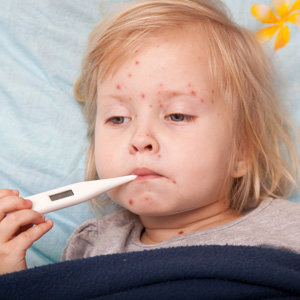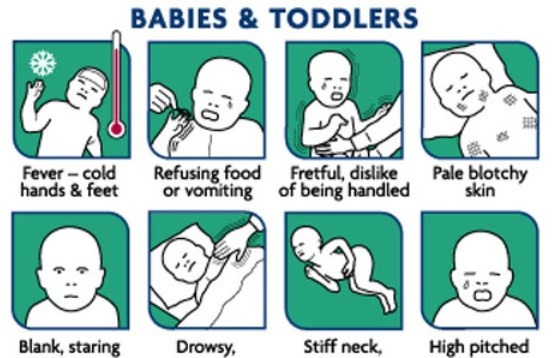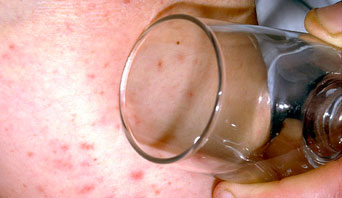 Parents do everything in their power to keep their children safe and healthy. However, there are sometimes uncontrollable circumstances in the form of diseases that can threaten this. One of the childhood diseases that strikes fear in many parents is meningitis. The following article will explain the disease concisely because being forewarned is forearmed. You can save your child’s life with your vigilance and prompt action.
Parents do everything in their power to keep their children safe and healthy. However, there are sometimes uncontrollable circumstances in the form of diseases that can threaten this. One of the childhood diseases that strikes fear in many parents is meningitis. The following article will explain the disease concisely because being forewarned is forearmed. You can save your child’s life with your vigilance and prompt action.
What Are the Warning Signs of Meningitis?
Obvious signs and symptoms can be obscure in meningitis in toddlers. This is because sometimes only part of the symptoms may appear. These can be often confused with the common flu because they closely resemble flu-like symptoms. Typical signs and symptoms include:
- Vomiting

- No interest in food or fluid intake
- Being tired and unresponsive
- Stiff neck or neck pain
- Fever
- Headache
- Eyes being sensitive to light
Note
Bacterial meningitis sometimes can also cause a skin rash. The appearance of this rash is like tiny pinpricks and can occur anywhere on the body. If left untreated, the rash may develop into purple bruising. This will be harder to spot in darker complexioned children. You should check paler areas of the body. You can press the side of a clear drinking glass to the rash to see it clearly. If you suspect that your toddler has meningitis, seek urgent medical attention. This disease progresses rapidly, so it requires a quick diagnosis and prompt treatment.

How Is Meningitis in Toddlers Diagnosed?
The doctor will have to perform certain tests to positively diagnose meningitis.
1. Primary Check
He/she may begin preliminary diagnosis by asking questions about symptoms, checking the child’s temperature, taking the pulse rate, testing the blood pressure, etc.
2. Fluid Tests
The doctor may conduct blood tests and even a lumbar puncture (spinal tap) which entails removing a sample of spinal fluid which surrounds the brain and spinal cord from the child’s lower spine with a hollow needle. Testing the fluid will be able to confirm if it is infected by bacteria or virus.
3. Intravenous Injection
Antibiotics are often administered intravenously even before a positive diagnosis because the disease can progress very rapidly. The doctor will even prescribe intravenous fluids to prevent dehydration and to keep the blood pressure at a safe level.
4. Scans
A chest x-ray scan may be ordered to determine if there is any infection in the toddler’s lungs. If the doctor suspects that there may be other underlying causes or problems, a CT scan is performed. These aggravating circumstances can occur if there is trauma, a lack of fever, an increase in pressure on the brain or a suspected brain abscess, etc.
Treatments for Meningitis in Toddlers
The treatments for Meningitis depend on the causes. The causes of meningitis can be viruses or bacteria infection. Viral meningitis is less severe compared to bacterial meningitis. Other rare causes include drug interactions, parasites or immune system disorders.
1. Medications
Antibiotics form the mainstream of therapy for bacterial meningitis. The dosage will be calculated according to the weight of the toddler. Be sure to mention any allergies that the child may have. Children with viral meningitis, who do not have any other complications, may be sent home with supportive medications. These medications will control the pain and fever, like Ibuprofen. Please note that antibiotics are not effective against viral meningitis. Continued check-ups with the doctor are required to monitor the child.
2. Hospital Admission
Children with bacterial meningitis will be kept under close supervision in the hospital. Oxygen may be administered to make breathing easier if breathing is labored. Monitors are attached to the child to track heart rate, respiratory rate and oxygen levels. IV fluids are given to maintain a suitable blood pressure and to prevent further dehydration.
Note
If the child is diagnosed with meningococcal meningitis, all persons in direct contact with the child is required to get antibiotic therapy. These people could be parents, caregivers, family members or others that have close contact with the child.
Complications of Meningitis in Toddlers
When the meninges are infected, they lose the protective function and allow contaminants to enter near the brain and spinal cord. These contaminants can cause inflammation and lead to decreased blood flow to the infected areas. There are some serious consequences to meningitis in toddlers. Depending on the severity of the infection, the child may develop long-term problems like visual impairment, hearing problems, seizures or mental function impairment.
How to Prevent Meningitis in Toddlers
1. Preventive Measures
Meningitis can be spread in the following ways, thus it’s imperative for you to keep your child away from the spreading source.
- An infected person who sneezes or coughs near the child
- Touching or kissing
- Sharing personal items like eating utensils or toothbrushes
- Poor personal hygiene
2. Vaccination
There are recommended vaccines available that can help the body to build the immunity against the disease. Doses are scheduled at different ages to gradually build up immunity.
- Haemophilus Influenzae Type B (Hib)
The initial dose should be administered at two months, then at three months and lastly at four months.
- Pneumococcal Conjugate Vaccine (PCV)
It is first administered at two months, then four months and the last dose is at thirteen months.
- Meningococcal B and C Vaccine
They are given at two months, four months and twelve months.
- ?Common Side Effects of the Vaccines
Side effects may include pain or discomfort at the injection site. A few toddlers may develop a slight fever, headache and lethargy. In most children the vaccine side effects are mild and the prevention of meningitis in toddlers far outweighs the mild temporary discomfort of the vaccine.
